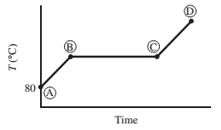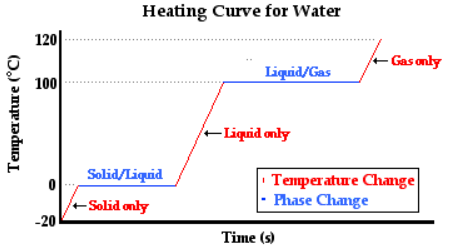
Concept explainers
Ten mL of pure liquid water in a cylinder with a movable piston is heated at a constant pressure of 1 atm from an initial temperature of 80°C. The temperature of the system is monitored, and the following behavior is observed:

(a) What is happening in steps AB, BC, and CD? What is the temperature corresponding to the horizontal portion of the curve?
(b) Estimate the volume occupied by the water at points B and C. (Assume the vapor follows the ideal-gas equation of state.)
(a)
Interpretation:
Identify the process in AB, BC, CD areas and calculate horizontal zone temperature.
Concept introduction:
Energy is transferred into a system when it is heated. The system will change depending on the energy it receives. This can happen through increase in temperature. A heating curve is called a plot of the temperature versus time.

Answer to Problem 6.1P
- AB − Water liquid heating zone (temperature increase)
- BC − Vaporization of water (liquid to gas phase)
- CD − water vapor (gas phase) heating zone
Horizontal portion temperature = 100°C
Explanation of Solution
AB Step
As heat is absorbed, the temperature of the liquid begins to increase this is due to the increase in the kinetic energy of the molecules of liquid. For standard atmospheric pressure, the rise in temperature takes place until it reaches to 100°C. With increasing temperature, the volume of the liquid remains constant due to little expansion for liquids.
BC Step
At this point, the heat is consumed to begin vaporization of liquid. This temperature is known as the bubble point temperature. Due to change in the previous state, the temperature remains constant and water molecules are moving from liquid to vapor phase. At point C, the last drop of liquid gets evaporated.
CD Step
The temperature increases above 100 °C, when heating steam boils all the liquid into vapor. This cause increase in the volume. Step B shows transition of liquid to vapor. The boiling point of water is 100 °C (liquid here is water) and pressure is 1 atm.
(b)
Interpretation:
Volume occupied by water at point B and C should be calculated.
Concept introduction:
The ideal gas equation is represented as follows:
Here,
Answer to Problem 6.1P
At point B, the water is present as liquid only thus, the volume will be 10 mL
At point C
Explanation of Solution
At point B, the water is present as liquid only thus, the volume will be 10 mL
The number of moles in 10 mL of liquid water is calculated as follows:
The volume of vapor can be calculated using the ideal gas equation as follows:
Here, number of moles is 0.555 mol at 1 atm and
Putting the values,
Thus, at point C, the volume occupied by the water occupies is 17 L.
At point C,
Want to see more full solutions like this?
Chapter 6 Solutions
EBK ELEMENTARY PRINCIPLES OF CHEMICAL P
Additional Science Textbook Solutions
Elements of Chemical Reaction Engineering (5th Edition) (Prentice Hall International Series in the Physical and Chemical Engineering Sciences)
Process Dynamics and Control, 4e
Experiencing MIS
Starting Out with C++: Early Objects
Starting Out with Java: Early Objects (6th Edition)
Starting Out With Visual Basic (8th Edition)
- 2. A system consists of 1 mole of ideal gas is taken through the cycle shown below from (1→2 →3). For this ideal gas, Cp = 5R/2 and C+ = 3R/2 (a) Determine the temperature (in units of K to 4 sig. figs) at the points, 1, 2, and 3 For (b), (c), and (d) please report q, w, AU, and AH in units of kJ to 3 sig. figs. If an answer is 0, then just put 0 for the answer. (b) Calculate q, w, AU, and AH for step 1-2 (in other words as the system is taken from an initial state at point 1 to a final state at point 2) (c) Calculate q, w, AU, and AH for step 2→3 (d) Calculate q, w, AU, and AH for step 3→1 1.0 P (atm) 0.5 1 22.4 isotherm V (dm³) 44.8arrow_forwardAssume you are interested in exploring the use of ammonium nitrate (NH4NO3) as the active ingredient in an inexpensive home-made cold pack. You decide that a practical cold pack should be able to depress the temperature of 1 kg of human muscle tissue by 5 oC. Now you need to know the amount of NH4NO3 required to achieve this. Ammonium nitrate is a highly water soluble solid. You believe the enthalpy of dissolution for NH4NO3 must be determined. To this end, you add 2.339 g of NH4NO3 to 99.7 mL of water at 23.7 °C in a constant-pressure calorimeter and close the calorimeter. The temperature of the water decreases to a minimum of 21.9 °C. 1a. Assume the density and specific heat of water is 1.00 g/mL and 4.184 J/g °C, respectively. Using the data above, determine the for ammonium nitrate in water. Assume the heat capacity of the calorimeter is negligible.arrow_forwardYou add 28 g of ice (H2O) at 0°C to 179 g of H20 (I) at 63°C at a constant pressure of 1.01 kPa. Calculate the final temperature in K. [AfusH°(H20) = 6.01 kJ mol""; Tfus=273.15 K; Cp.m(H20,)=75.3 J mol Kl; m(H20)=18.02 u].arrow_forward
- Ideal Gas Law The pressure P, temperature T, and volume V ofan ideal gas are related by PV = nRT, where n is the number ofmoles of the gas and R is the universal gas constant. For the pur-poses of this exercise, let nR = 1; therefore, P = T/V.a. Suppose that the volume is held constant and the temperatureincreases by ∆T = 0.05. What is the approximate change inthe pressure? Does the pressure increase or decrease?b. Suppose that the temperature is held constant and the volumeincreases by ∆V = 0.1. What is the approximate change in thepressure? Does the pressure increase or decrease?c. Suppose that the pressure is held constant and the volume in-creases by ∆V = 0.1. What is the approximate change in thetemperature? Does the temperature increase or decrease?arrow_forward3. One mole of liquid water at 100 °C is heated until the liquid is converted entirely to vapor at 100 °C and 1 atm pressure. Calculate q, w, AE and AH for each of the following. (a) The vaporization is carried out in a cylinder where the external pressure on the piston is maintained at 1 atm throughout. (b) The cylinder is first expanded against vacuum (Pext = 0) to the same volume as in part (a), and then sufficient heat is added to vaporize the liquid completely to 1 atm pressure.arrow_forwardC(diamond) + 2H2(g)= CH4 At 298 Kelvin and pressure of 1000 atm Kp=p(CH4)/p^2H2 In the above equation why is H2 (gas) and CH4(g) included and C(diamond) excluded, using activities.arrow_forward
- Q\3: Oxygen gas produced from the reaction below was collected above the water at 30 Cº and in a container has capacity 150 cm³ until the total pressure reached 80.0 kPa. 2KCIO32KCl +30₂ If the vapor pressure of water at 30 C° equal to 4.24 KPa. Determine: 1. The mass in (g) of dry oxygen produced. 2. The mass in (g) of KCIO3that consumed in reaction. {K = = 40 9 0 = 16 mole 9 Cl = 35.5- R = 8.314 mole mole N.m mole. Karrow_forwardWater and acetonitrile, CH3CN, are miscible (can be mixed in any proportions). However, whenwater and acetonitrile are mixed, the volumes are not additive (the total volume of the resultingsolution is not equal to the sum of the pure liquid volumes). For example, when 100.0 mL ofwater and 100.0 mL of CH3CN(l), are mixed at 20 °C, the total volume of the solution is 192.0mL,not 200.0 mL.a. Provide an explanation for this phenomenon.b. Calculate the molarity, molality and mol fraction of CH3CN in a solution preparedby mixing 100.0 mL of water and 100.0 mL of CH3CN(l) at 20 °C. The total volume of themixture is 192.0 mL and the densities of water and acetonitrile are 0.998 g/mL and 0.782g/mL, respectively, at this temperature.c. When 70.0 g H2O and 190.0 g CH3CN(l) are mixed, to resulting solution has adensity of 0.860 g/mL at 20 °C. Calculate the volumes of the pure liquid samples and thesolution, and show that the pure liquid volumes are not additive.arrow_forwardA 1.22 kg piece of iron at 126.5ºC is dropped into 981 g water at 22.1ºC. The temperature rises to 34.4ºC. What will be the final temperature if this same piece of iron at 99.8ºC is dropped into 350. mL of glycerol, C 3 H8 O3 (l), at 26.8ºC? For glycerol, ρ = 1.26 g/mL, cp = 219 J/mol-Karrow_forward
- What is AG for the decomposition of CaCO3 at 298 K and a partial pressure of CO2 of 4.00x10-4 bar? CaCO3(s) → CaO(s) + CO2(g) AGrxn (298 K, Pco2 = 0.400 mbar) = ??? CO2(g) Compound AG°; (kJ mol·1) CACO3(s) СаО(s) -1129 -604 -394arrow_forwardF 6. A rigid vessel of volume 0.4 m^3 containing H2 at 21.25°C and a pressure of 715x10^3 Pa is connected to a second rigid vessel of volume 0.75m^3 containing Argon at 30.15°C at a pressure of 203x10^3. A valve separating the two vessels is opened and the mixed gases allowed to cool to a temperature of 12.2°C. What is the final pressure of the gas mixture in the connected vessel in atm? (1 atm = 101325 Pa) Please show all steps.arrow_forward(a) Use the following data for NH3 (g) at T = 273 K to evaluate B2P (T). (Here Z is the compressibility factor, PV/RT). P (bar) 0.10 0.20 0.30 0.40 0.50 0.60 0.70 Note: You will need to fit this data to a least-squares line. (b) At standard temperature (273.15 K), the density of O₂ varies with pressure as indicated in the table below: P (bar) 0.25331 0.50663 0.75994 1.01325 Z-1 1.519 x 10-4 3.038 x 10-4 4.557x 10-4 6.071 x 10-4 7.583 x 10-4 9.002 x 10-4 1.0551 x 10-3 2 p(g/L) 0.356985 0.714154 1.071485 1.428962 Use this data to find the second virial coefficient, B2v, of oxygen. Note that mo2 = 31.9988 Daltons. (Hint: It will be useful to determine the molar volume from each value of p.)arrow_forward
 ChemistryChemistryISBN:9781305957404Author:Steven S. Zumdahl, Susan A. Zumdahl, Donald J. DeCostePublisher:Cengage Learning
ChemistryChemistryISBN:9781305957404Author:Steven S. Zumdahl, Susan A. Zumdahl, Donald J. DeCostePublisher:Cengage Learning ChemistryChemistryISBN:9781259911156Author:Raymond Chang Dr., Jason Overby ProfessorPublisher:McGraw-Hill Education
ChemistryChemistryISBN:9781259911156Author:Raymond Chang Dr., Jason Overby ProfessorPublisher:McGraw-Hill Education Principles of Instrumental AnalysisChemistryISBN:9781305577213Author:Douglas A. Skoog, F. James Holler, Stanley R. CrouchPublisher:Cengage Learning
Principles of Instrumental AnalysisChemistryISBN:9781305577213Author:Douglas A. Skoog, F. James Holler, Stanley R. CrouchPublisher:Cengage Learning Organic ChemistryChemistryISBN:9780078021558Author:Janice Gorzynski Smith Dr.Publisher:McGraw-Hill Education
Organic ChemistryChemistryISBN:9780078021558Author:Janice Gorzynski Smith Dr.Publisher:McGraw-Hill Education Chemistry: Principles and ReactionsChemistryISBN:9781305079373Author:William L. Masterton, Cecile N. HurleyPublisher:Cengage Learning
Chemistry: Principles and ReactionsChemistryISBN:9781305079373Author:William L. Masterton, Cecile N. HurleyPublisher:Cengage Learning Elementary Principles of Chemical Processes, Bind...ChemistryISBN:9781118431221Author:Richard M. Felder, Ronald W. Rousseau, Lisa G. BullardPublisher:WILEY
Elementary Principles of Chemical Processes, Bind...ChemistryISBN:9781118431221Author:Richard M. Felder, Ronald W. Rousseau, Lisa G. BullardPublisher:WILEY





